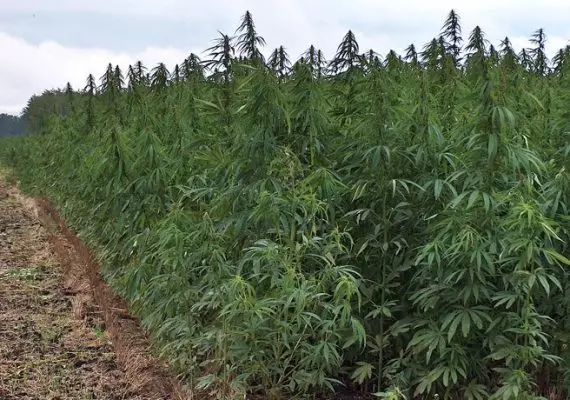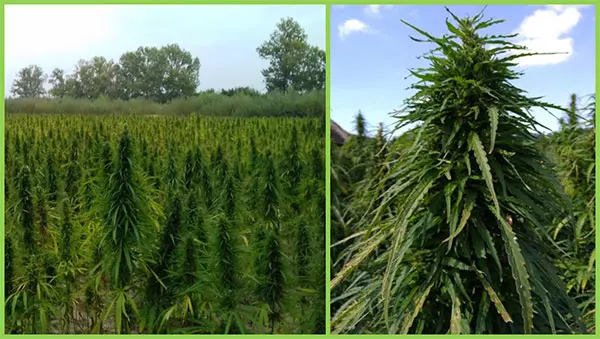
CULTIVATION OF HEMP IN POLAND AND AROUND THE WORLD
Hemp (Cannabis sativa L.) is an annual plant from the Cannabaceaefamily, known since ancient times. The first mentions of hemp were found in Memphis. They were engraved on the stones of the pyramid and are dated to around 2350 BCE (Kędzia et al., 2016). In Poland, the first written records of the medicinal use of hemp were made in the 17th century by Szymon Syreński – a physician, botanist, and professor at the Krakow Academy. At the turn of the 19th and 20th centuries, this plant was cultivated on almost every farm in our country. Fabrics were made from it, and clothes were sewn. Even in the 1960s, the area of hemp cultivation in Poland was around 30,000 hectares.
In subsequent years, the area of cultivation of this plant decreased and currently amounts to around 800–1000 hectares (Kaniewski et al., 2017, Statistical Yearbook of Agriculture 2018). The cultivation of industrial hemp in Poland is regulated by the Act of July 29, 2005, on Counteracting Drug Addiction – Journal of Laws No. 179, item 1485. This law specifies, among other things, the maximum permissible content of the psychotropic substance (Δ9-tetrahydrocannabinol) in hemp, which cannot exceed 0.2% (Mańkowska et al., 2015). Currently, hemp (Cannabis sativa L.) is cultivated to obtain seeds and fiber (Fig. 1), which is used by the textile industry and for the production of non-textile products used in construction, automotive, paper, and composite industries. This plant is also used for phytoremediation of anthropogenically polluted soils.

Fig.1. Hemp seed plantation of cv. Henola. The typical inflorescence of this variety destined for seed harvest (www.ior.poznan.pl/plik,3701,metodyka-integrowanej-ochrony-konopii-pdf.pdf)
PROPERTIES OF HEMP
Hemp seeds contain vitamin E, iron, calcium, zinc, phosphorus, and magnesium. Vitamin E affects the elasticity of blood vessels, improves blood circulation, and reduces the risk of atherosclerosis. It is an antioxidant that protects, among other things, omega-3 fatty acids from oxidation. Hemp seeds contain about 20–25% protein and 28–35% oil, which contains a significant amount of unsaturated fatty acids essential for human health. Extracted from seeds and inflorescences, oil and essential oils are used in the cosmetics, food, agriculture, and veterinary industries (Burczyk, 2016, Kędzia et al., 2016).
Scientific research has also shown that hemp oil and essential oils have health-promoting and therapeutic properties. They have anti-inflammatory, analgesic, anticonvulsant, sedative, antidepressant, antiemetic, antidiabetic, anti-atherosclerotic, anticancer, antibacterial, antifungal, and antiviral effects (Das and Mishra, 2011; Kędzia et al., 2016; Lancz et al., 1991; Monika et al., 2014; Radwan et al., 2009; Sharma et al., 2014). The beneficial pharmacological effect of hemp will likely contribute to an increase in the cultivation area of this plant in Poland and other countries worldwide.
CULTIVATION OF HEMP – REQUIREMENTS, LIMING
Fertile soils, rich in nutrients, with good structure, easy heating, regulated water relations, and soil pH, as well as rich in calcium, are suitable for hemp cultivation. The content of this element in the soil should be 800–1000 mg Ca·dm-3. The optimal soil reaction for hemp cultivation is neutral or alkaline – pH 7.0–7.6 (Wójtowicz et al., 2018). Soils with a pH of 6.0 and lower should be limed to raise the reaction to the optimal level. Liming should be done in the autumn.
The lime dose should be determined based on the results of soil sample analysis conducted at the District Chemical-Agricultural Station or other accredited laboratory performing soil chemical analyses. In the absence of current analysis results for acidified soils, it is recommended to use Kujawit lime fertilizer at a dose of 2.0–2.5 t·ha-1 (lighter soils) or 3.0–3.5 t·ha-1 (heavier soils). This fertilizer should be thoroughly mixed with the plowed soil layer. It is applied before plowing or winter plowing. Kujawit lime fertilizer should not be used in combination with manure or other organic fertilizers. In such a situation, after plowing the fertilizer, it is necessary to wait for about 8–10 weeks and then apply granulated carbonate lime Polcalc III Generation or SuperMag (in case of low magnesium content in the soil) at a dose of 600–1000 kg·ha-1 on the soil surface.
The mentioned granulated fertilizers should also be used for soils with a pH slightly deviating from the optimal for hemp cultivation, at a dose not exceeding 1000 kg·ha-1. In this case, Polcalc III Generation or SuperMag should be applied after winter plowing, when soil and climatic conditions allow (no snow cover, a thawed 5-centimeter layer of soil during the day, with freezing below). If liming was not carried out in the autumn or winter, granulated carbonate lime Polcalc III Generation or granulated magnesium carbonate lime SuperMag (in case of low magnesium content in the soil) can be applied at a dose of 600–1000 kg·ha-1 in early March, 3–4 weeks before planned sowing of fertilizers containing nitrogen in the ammonium or amide form and phosphorus.
Maintaining this several-week gap between fertilizers is necessary because the granulated carbonates Polcalc III Generation and SuperMag produced by our company are characterized by very high reactivity (65-99%), resulting from an innovative production method. They are produced from crushed lime flour – Polcalc III Generation or dolomitic SuperMag, with 50% of particles having a diameter smaller than 0.02 mm. The degree of fragmentation of lime affects its chemical activity and dissolution rate in the soil environment. The more dusty fractions the fertilizer contains, the greater its reaction surface with soil solutions. Then, lime flours are subjected to the granulation process, and the obtained granules of Polcalc III Generation and SuperMag fertilizers have sizes of 2–8 mm.
Granulated lime fertilizers produced by Polcalc Lime Fertilizers Sp. z o. o. should not be used under the plow because deeper burial by soil significantly reduces their acidifying and fertilizing function.






